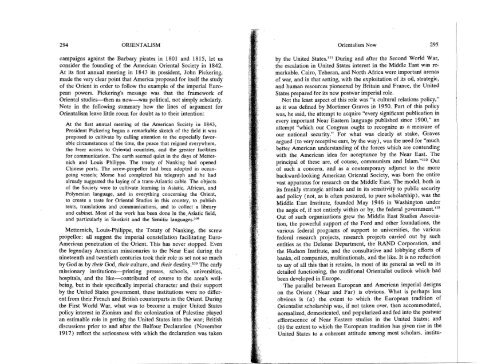Orientalism - autonomous learning
Orientalism - autonomous learning
Orientalism - autonomous learning
You also want an ePaper? Increase the reach of your titles
YUMPU automatically turns print PDFs into web optimized ePapers that Google loves.
294 ORIENT ALISM<br />
<strong>Orientalism</strong> Now<br />
295<br />
campaigns against the Barbary pirates in 1801 and 1815, let us<br />
consider the founding of the American Oriental Society in 1842.<br />
At its first annual meeting in 1843 its president, John Pickering,<br />
made the very clear point that America proposed for itself the study<br />
of the Orient in order to follow the example of the imperial European<br />
powers. Pickering's message was that the framework of<br />
Oriental studies-then as now-was political, not simply scholarly.<br />
Note in the following summary how the lines of argument for<br />
<strong>Orientalism</strong> leave little room for doubt as to their intention:<br />
At the first annual meeting of the American Society in 1843,<br />
President Pickering began a remarkable sketch of the field it was<br />
proposed to cultivate by calling attention to the especially favorable<br />
circumstances of the time, the peace that reigned everywhere,<br />
the freer access to Oriental countries, and the greater facilities<br />
for communication. The earth seemed quiet in the days of Metternich<br />
and Louis Philippe. The treaty of Nanking had opened<br />
Chinese ports. The screw-propellor had been adopted in oceangoing<br />
vessels; Morse had completed his telegraph and he had<br />
already suggested the laying of a trans-Atlantic cable. The objects<br />
of the Society were to cultivate <strong>learning</strong> in Asiatic, African, and<br />
Polynesian language, and in everything concerning the Orient,<br />
to create a taste for Oriental Studies in this country, to publish<br />
texts, translations and communications, and to collect a library<br />
and cabinet. Most of the work has been done in the, Asiatic field,<br />
and particularly in Sanskrit and the Semitic languages. lo9<br />
Metternich, Louis-Philippe, the Treaty of Nanking, the screw<br />
propellor: all suggest the imperial constellation facilitating Euro<br />
American penetration of the Orient. This has never stopped. Even<br />
the legendary American missionaries to the Near East during the<br />
nineteenth and twentieth centuries took their role as set not so much<br />
by God as by their God, their culture, and their destiny. no The early<br />
missionary institutions-printing presses, schools, universities,<br />
hospitals, and the like-contributed of course to the area's wellbeing,<br />
but in their specifically imperial character and their support<br />
by the United States government, these institutions were no different<br />
from their French and British counterparts in the Orient. During<br />
the First World War, what was to become a major United States<br />
policy interest in Zionism and the colonization of Palestine played<br />
an estimable role in getting the United States into the war; British<br />
discussions prior to and after the Balfour Declaration (November<br />
1917) reflect the seriousness with which the declaration was taken<br />
by the United States. 111 During and after the Second World War,<br />
the escalation in United States interest in the Middle East was remarkable.<br />
Cairo, Teheran, and North Africa were important arenas<br />
of war, and in that setting, with the exploitation of its oil, strategic,<br />
and human resources pioneered by Britain and France, the United<br />
States prepared for its new postwar imperial role.<br />
Not the least aspect of this role was "a cultural relations policy,"<br />
as it was defined by Mortimer Graves in 1950. Part of this policy<br />
was, he said, the attempt to acquire "every significant publication in<br />
every important Near Eastern language published since 1900," an<br />
attempt "which our Congress ought to recognize as a measure of<br />
our national security." For what was clearly at stake, Graves<br />
argued (to very receptive ears, by the way), was the need for "much<br />
b~tter American understanding of the forces which are contending<br />
with the American idea for acceptance by the Near East. The<br />
principal of these are, of course, communism and Islam."112 Out<br />
of such a concern, and as a contemporary adjunct to the more<br />
backward-looking American Oriental Society, was born the entire<br />
vast apparatus for research on the Middle East. The model, both in<br />
its frankly strategic attitude and in its sensitivity to public security<br />
and policy (not, as is often postured, to pure scholarship), was the<br />
Midl::Ue East Institute, founded May 1946 in Washington under<br />
the aegis of, if not entirely within or by, the federal government. ll8<br />
Out of s\,Jch organizations grew the Middle East Studies Association,<br />
the powerful support of the Ford and other foundations, the<br />
various federal programs of support to universities, the various<br />
federal research projects, research projects carried out by such<br />
entities as the Defense Department, the RAND Corporation, and<br />
the Hudson Institute, and the consultative and lobbying efforts of<br />
banks, oil companies, multinationals, and the like. It is no reduction<br />
to say of all this that it retains, in most of its general as well as its<br />
detailed functioning, the traditional Orientalist outlook which had<br />
been developed in Europe.<br />
The parallel between European and American imperial designs<br />
on the Orient (Near and Far) is obvious. What is perhaps less<br />
obvious is (a) the extent to which the European tradition of<br />
Orientalist scholarship was, if not taken over, then accommodated,<br />
normalized, domesticated, and popularized and fed into the postwar<br />
efflorescence of Near Eastern studies in the United States; and<br />
(b) the extent to which the European tradition has given rise in the<br />
United States to a coherent attitude among most scholars, institu
















